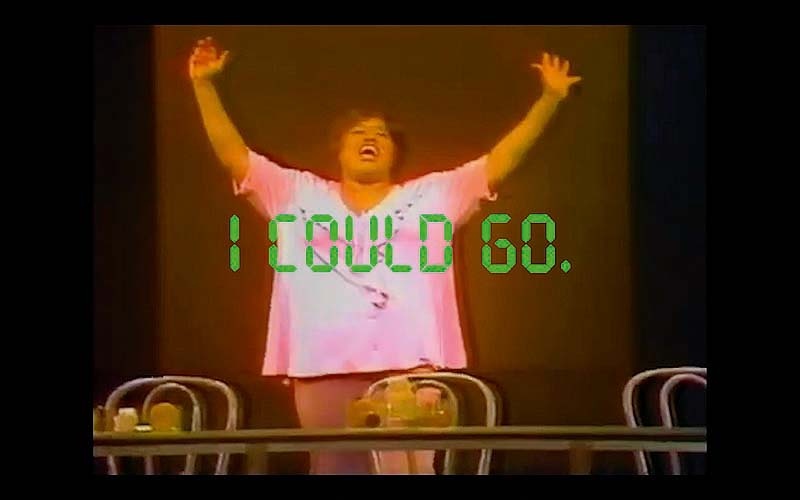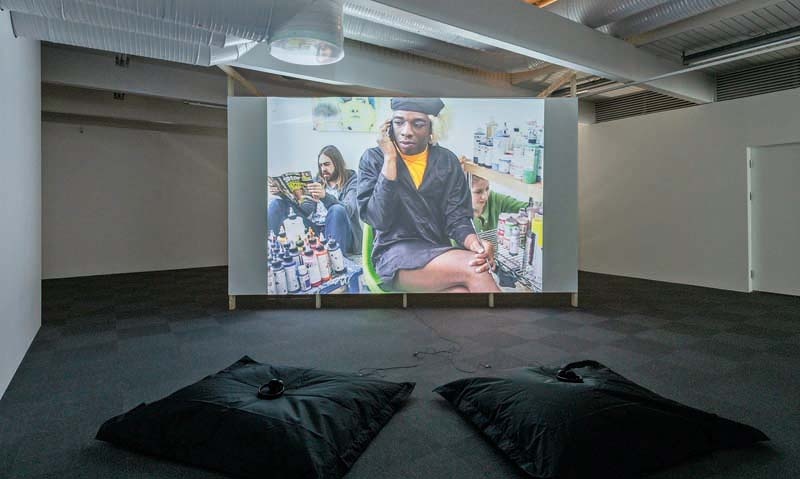THIS WAS NOT MADE FOR YOU Heather Jones on “Lean” at Kunsthall Stavanger

Krista Gay, “BLKPussy_error,” 2021, video still
The exhibition “Lean,” on view at Kunsthall Stavanger, is frustrating in the best possible way. Drawing a neat conclusion is impossible – and without a doubt this is entirely intentional. Curated by Legacy Russell and originally conceived and presented as an online exhibition for Performa’s Radical Broadcast, the exhibition at Kunsthall Stavanger gathers eight artists whose work taken together is, as Russell puts it, a “Black vernacular and queer poetic proposition.”
Rather than a wide-reaching survey, the exhibition is razor-sharp in its choice of artworks. Russell has managed to curate an intellectually pointed, emotionally rich, and socially challenging constellation while avoiding the pitfalls common to group shows. By centering the exhibition around the word “lean” – as lexicon, as cultural and art-historical reference, as physical placement – the curator created breathing room for artistic and narrative nuance. For this version of “Lean,” Russell has brought together eleven video works that, viewed collectively, create an intimacy and community with one another but also insist on their own individuality.
The exhibition begins immediately upon entering the building. To the left of the entrance door, Jen Everett’s silent video Happy New Year (2018) plays on a midsize monitor. The video presents 54 seconds of subtly reworked black-and-white footage of a New Year’s Eve party at Everett’s childhood home in Detroit, filmed by the artist’s father. As one of the most visually and audibly quiet works, its placement by the door is regrettable, as it could potentially be overlooked. It nevertheless holds its own, offering an intimate portrait of four Black women at a specific moment in time, while simultaneously providing a complex commentary on the male gaze by capturing their spontaneous engagement with or refusal of the camera lens.
Further into the lobby, Justin Allen’s Explain Totality (version 3) (2018) plays on a monitor near the entrance to the main gallery. It is difficult to imagine any of the other videos working in this space. However, the video’s documentary nature – an eleven-minute recording of Allen’s athletic commentary on race and suburbia in the United States – subtly reminds the viewer that this performance was made to be seen by a large group at once, and therefore its placement is completely appropriate.
Opposite the building’s entrance, double doors open to reveal large, asymmetrically placed walls flanking either side of the main gallery. The exhibition text quotes theorist and professor Kemi Adeyemi on the “distinctly gendered and racialized” alignment of the 90-degree angle; it is only logical that the physical format of the exhibition defies this. The viewer is met by Devin Kenny’s (mainly) audio work Lean (20hz 'dando repeat barline rmx) (2020) and Sadé Mica’s videos With me Mam in Malham (2019) and Posturin (2018). Kenny’s contribution is the only work in the gallery with projected sound, and the artist’s chopped-and-screwed compilation of references – including Neil deGrasse Tyson and Gil Scott-Heron, along with samples from popular hip-hop songs – shifts our perspective on the collective Black experience into cosmic terms.
Mica’s work speaks to both the liberation and restriction of eschewing traditional gender expectations in favor of the affirmation of nonbinary selfhood. While Posturin lays bare the tension between identity and bodily reality through a poetic exploration of the practice of chest binding, With me Mam in Malham speaks to the politics of a body in relationship to a landscape and to others – in this case, the artist’s mother.
Serving as a counterweight to Mica’s quietly composed actions, a projection of Rene Matić’s work Brown Girl in the Art World III (2019) portrays the artist energetically dancing in front of a pub, superimposed with audio of Matić discussing their work during an art school critique. Matić speaks to the tension of existing and trying to make artwork as a Black, queer, British femme and concludes that “to create an image that is my own sense of what I feel I look like when I am free is enough.” At the opposite end of the space, Kalup Linzy’s Art Jobs and Lullabies, Video Suite 1 (2015) and KK Queens Survey (2005) loop one after the other, presenting Linzy’s well-recognized appropriation of pop culture and melodrama in order to critique race, gender, sexuality, and the art world itself.

Kalup Linzy, “KK Queens Survey,” 2005
Stairs lead from the gallery to a screening room directly below, where Leilah Weinraub’s explosive documentary SHAKEDOWN (2018) plays at scheduled intervals. It is here that the curatorial mention of architecture as an active entity strikes a particularly strong resonance. Over the course of 71 minutes, Weinraub follows the personalities and events surrounding the eponymously named Los Angeles strip club. In its affectionate documentation of a space specifically dedicated to Black, lesbian pleasure, Weinraub’s SHAKEDOWN allows the now-defunct club to reincarnate here in the gallery space.
Krista Gay’s videos BLACK PUSSY (2020) and BLKPussy_error (2021) are additions to the original exhibition and are presented solely on Kunsthall Stavanger’s website. Not only are the artworks fitting for an online context – their source material mined from cyberspace – the web presentation also pays homage to the online format of the original exhibition and helps to further expand the exhibition beyond the gallery space.
The artworks in “Lean” are provocative to varying degrees in content and form; the placement and display of the artworks, however, are not. The decision to present these artworks in a physical space, and in the specific context of Stavanger, proves to be the most interesting. By pulling the exhibition from a digital context into a physical one, the artists’ bodies, histories, and practices are literally allowed to take up space in this environment. The city of Stavanger, on the southwest coast of Norway, is perfectly situated to serve as a hub for the North Sea oil trade. It is largely defined by a wealthy, white, socially conservative upper class, and the Kunsthall is located in Eiganes, an affluent neighborhood desirable for its large, historic homes and proximity to the royal residence Ledaal. The presentation of “Lean” in this context seems incongruous at first: this collection of artworks is as far from a Scandinavian, white, cultural elite as possible. Are the artworks’ messages applicable here? Upon reflection, their presentation in Stavanger is more necessary than many exhibitions that have been on view in the city in recent years.
In Norway, there exists an unfounded pride that issues of race, class, and discrimination don’t exist in the country. Of course this couldn’t be more false, and the presentation of “Lean” raises taboo questions while affirming lived experiences specific to this city and country. While the issues of identity and power presented in these works are felt in Norway, they are far less openly discussed. Further, as US pop culture – music, movies, television, fashion, art, language – circulates around the world, so too should a critique of the notions of race and gender embedded in that culture.
There are infinite takeaways from each artwork presented in “Lean,” as well as from the curation of the exhibition as a whole. Russell’s assertion of “Lean” is a hopeful one: “a performative and political proposal for new worlds to be dreamt up and built, and new ways of reading, listening, becoming, being.” And yet, as a white cis woman viewing these works, it is the moments of exhaustion and refusal present in many of the videos that stay with me most. Days later, I think of Allen’s heavy breathing toward the end of his performance, body gleaming with sweat. I remember the telling eye-roll of the seated Black woman in Everett’s archival New Year’s Eve footage. I’m plagued by the incredibly uncomfortable video Go With The Flow (“Enough” and “Dream”) placed in the middle of Linzy’s video suite in which we watch the artist struggle in rapid water while bystanders wonder aloud if they should help. I am struck by the power in Gay’s total refusal to engage in the dominant narrative as a computerized voice reads, “I won’t feed on your propaganda. I won’t. Instead I will eat you alive.” In SHAKEDOWN, we witness multiple arrests (one of a fully naked Black woman by white male police officers) and the subsequent closing of the club. And in Matić’s work, after 9 minutes and 30 seconds of vigorous dancing, the artist leans over, hands on knees, breathing heavily while her voice-over narrates, “I’ve just spoken for about 10 minutes about Blackness and whiteness and you’re all probably not listening anymore.”
There is an ever-present tension between the attempt to communicate one’s experience and the exhaustion of trying to carve out an equal existence in an inherently discriminatory world order. Yes, there is celebration here, to be sure: of self-created identity, of community, of survival. And there is also a message to the cis-white viewers: this was not made for you. I’m reminded of a moment in SHAKEDOWN when one of the Shakedown Angels announces, “If you’re straight, you don’t need to be in the front.” In other words, you are welcome here, but your existence, your comfort, is not the chief concern of this exhibition. This frustrates an inherited sense of entitlement, and therein lies the profound curatorial accuracy.
“Lean,” Kunsthall Stavanger, March 4–April 25, 2021.
This text was republished in a Norwegian translation by Contemporary Art Stavanger. You can read the translation here.
